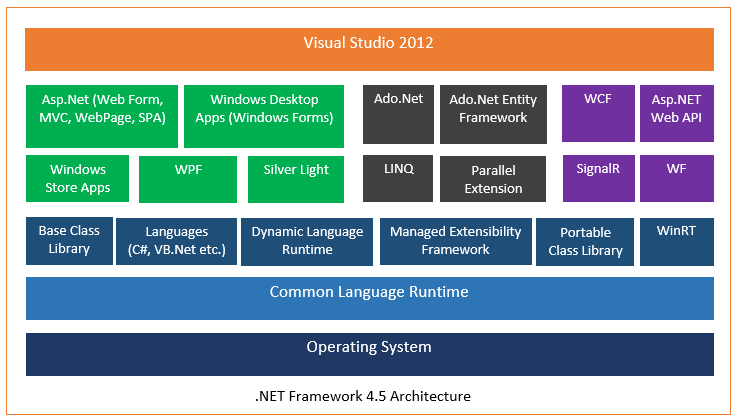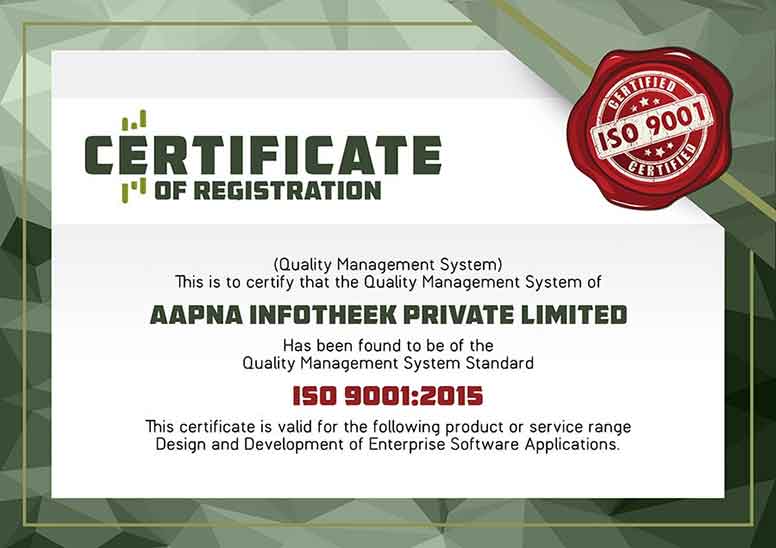The Microsoft .Net Framework is a comprehensive and an integrated programming model of the Windows operating system for building the next-gen applications. It is programmed with Dynamic Language Runtime (DLR), Common Language Runtime (CLR), Portable Class Library, Parallel Extension, Base Class Library (BCL) and WinRT.
The .NET Framework 4.0 includes the following new additions in BCL:
- Dynamic Language Runtime (DLR)
- Managed Extensibility Framework (MEF)
- Parallel Extension
- Entity Framework
- WCF Data Services
The .Net Framework also works alongside older Framework versions – .Net 3.5, 3.0, 2.0 – under the same hosting process.
Understanding the Components of Microsoft .Net Framework 4.5 Architecture
- Common Language Runtime (CLR)
This provides the environment to execute the .NET Framework programs. Moreover, it also takes care of memory management and thread management of all the .Net programs.
- Base Class Library (BCL)
The BCL functions as a library of various functionalities which are common for all the languages using the .Net Framework, comprising of classes and interfaces of reusable types.
- Portable Class Library (PCL)
The PCL project in Visual Studio 2012 enables you to write and develop managed assemblies that function on multiple .Net Framework platforms. One can choose their platform such as .NET Framework, Silverlight, Windows Phone 7, or Xbox 360 platforms to target, using the Portable Class Library project.
- Managed Extensibility Framework (MEF)
The MEF is a library that enables the generation of lightweight and extensible applications. It allows the app developers to discover and employ extensions without the use of any configurations.
- Dynamic Language Runtime (DLR)
This gives the runtime environment for languages like python and so forth to perform under the full control of the CLR.
- WinRT
The WinRT or Windows Runtime APIs provide the user interface functions for developing Windows Store apps and allow access to various features of Windows 8 or Windows RT OS. It supports native C++, HTML, C#, VB.NET, as well as JavaScript and TypeScript.
- Asp.Net
This helps in creating rich internet-based, website applications.
- Windows Store Apps (Metro Style Apps)
This is a new app specially designed to run on Windows 8 devices and can take the advantage of the features of the new WinRT APIs. The .Net Framework supports the Windows Store Apps which can only be distributed in the Windows 8 store.
- Desktop Apps (Windows Forms)
The Windows Desktop app is nothing but the traditional Windows application developed for the previous Windows versions like Windows XP, Windows Vista and Windows 7 but designated with a new name for Windows 8. The classic features of the Windows Desktop app include the Microsoft Office family products and notepad.
- Windows Presentation Foundation (WPF)
The WPF is used for rendering user interfaces to create applications with a rich user-experience. It comes with UI applications, 2D graphics, 3D graphics and multimedia. It is a resolution-independent engine that is built to take advantage of the hardware acceleration of modern graphics cards. Additionally, the WPF makes the UI perform faster.
- Silverlight
A web-based, cross-browser technology, Silverlight, enables designers and developers to create Rich Internet Applications (RIA) embedded in web pages.
- Ado.Net
It is a set of software components that allows the developers to create a Data Access Layer to access and manipulate data from underlying data sources like SQL Server, DB2, Oracle and so forth.
- Language-Integrated Query or LINQ
LINQ makes a query from various data sources such as SQL databases, XML documents, Ado.Net Datasets, Various Web services, Collections and Generics using Visual Basic or C#.
- Net Entity Framework
Ado.Net allows access into databases like SQL Server, Oracle, DB2 and so forth, and to accordingly process and update the data contained in them in an ORM fashion.
- Parallel Extension
With the use of Parallel Extension, developers can distribute their work code across various multiple processors in order to gain hardware advantage.
- Windows Communication Foundation (WCF)
WCF can be used to send across data as messages from a service endpoint to another using WS-* standards.
- ASP.NET Web API
ASP.NET Web API acts as a framework for creating HTTP services that are of use to a wide range of clients such as mobiles, iPhone and tablets and browsers.
- SignalR
ASP.NET SignalR is a library that facilitates the process of adding real-time web functionality to applications by making it less complicated. Real-time web functionality allows the server code push content to connected clients instantaneously, rather than having to wait for a client to request for new data.
- Visual Studio 2012
The Visual Studio IDE is a library of tools that facilitate the developers in writing and modifying the code for various programs, alongside detecting and rectifying errors. It is also used for developing Windows Store apps, mobile apps, desktop apps, ASP.NET web apps, and web services.
If you have a project requirement or want to associate with our company, connect with us, and we will get in touch with you.
Check out our guide on Help File Generation for ASP.NET Website Project.
Are you aware of the future trends in Mobile Application Development?
To know more about .Net Framework Architecture (CLI, CLR, Assemblies, Class library, App models etc.) check out https://en.wikipedia.org/wiki/.NET_Framework
Other Related Articles You Might Be Interested In
Help File Generation for ASP.NET Website Project (Using Sandcastle)
Common Myths About the Software Testing World
Software Development Project Estimation – Problems & Solutions








